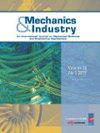新型脉动MQL环境下硬车削温度的实验与建模方法研究
IF 1.2
4区 工程技术
Q3 ENGINEERING, MECHANICAL
引用次数: 8
摘要
硬车削过程中总热量的产生对刀具磨损、刀具寿命和工件表面精加工质量有很大影响。因此,根据温度测量这种热量成为实现良好加工性能的必要条件。因此,本文对脉动MQL环境下4340级钢硬车削过程中三个不同区域的温度测量进行了新颖的研究。在三个不同的位置测量温度,即切屑-刀具界面,侧面和加工工作面(靠近刀具-工件接触),相应的位置温度称为切屑-刀具界面温度(T),侧面温度(Tf)和加工工作面温度(Tw)。温度T和Tf用k型热电偶测量,Tw用Fluke make红外热像仪测量。脉动MQL显著降低了温度,最高温度为110°C,对应于最高速度(200 m/min)条件下的切屑-刀具界面温度(T)。在每次试验中,温度的变化顺序为:T > Tf > Tw。从16个温度的平均值来看,T比Tf大14.42%,比Tw大39.36%,Tf比Tw大21.79%。实验结果表明,对T和Tf影响最大的是切削速度,其次是切削深度,而对Tw影响最大的是切削深度。此外,使用线性回归对这些温度进行预测,T、Tf和Tw响应的绝对平均误差(MAE)分别为1.848%、0.542%和3.766%。此外,使用WPCA(加权主成分分析)估计输入项的最佳设置,并发现dc1 (0.1 mm) - fr2 (0.08 mm/rev) - vc2 (100 m/min) - Pt2 (2 s)。本文章由计算机程序翻译,如有差异,请以英文原文为准。
Investigation on hard turning temperature under a novel pulsating MQL environment: An experimental and modelling approach
Generation of total heat in hard turning largely influenced the cutting tool wear, tool life and finishing quality of work-surface. Thus, the measurement of this heat in terms of temperature becomes a necessity for achieving favourable machining performances. Therefore, this work presents a novel study on temperature measurement in three different zones during hard turning operation of 4340 grade steel under pulsating MQL environment. Temperatures are measured at three different locations namely chip-tool interface, flank face, and machined work surface (near to tool-work contact) and the location wise temperature is termed as chip tool interface temperature (T), flank face temperature (Tf) and machined work surface temperature (Tw) correspondingly. The temperature T and Tf are measured with help of K-type thermocouple while Tw is measured by Fluke make infra-red thermal camera. Pulsating MQL significantly reduced the temperature as the maximum temperature is noticed 110 °C which corresponds to chip-tool interface temperature (T) at highest speed (200 m/min) condition. In each test, the order of temperature follow the trend as: T > Tf > Tw. Considering average of all 16 temperatures, T is 14.42% greater than Tf and 39.36% larger than Tw while Tf is 21.79% greater than Tw. Experimental results concludes that the cutting speed is the most influencing factor followed by depth of cut for both T and Tf, whereas depth of cut is the most influencing factor for Tw. Further, these temperatures are predicted using linear regression, and absolute mean error (MAE) for responses T, Tf, and Tw is noticed as 1.848%, 0.542%, and 3.766% individually. Additionally, the optimum setting of input terms are estimated using WPCA (weighted principal component analysis) and found to be dc1 (0.1 mm) − fr2 (0.08 mm/rev) − vc2 (100 m/min) − Pt2 (2 s).
求助全文
通过发布文献求助,成功后即可免费获取论文全文。
去求助
来源期刊

Mechanics & Industry
ENGINEERING, MECHANICAL-MECHANICS
CiteScore
2.80
自引率
0.00%
发文量
25
审稿时长
>12 weeks
期刊介绍:
An International Journal on Mechanical Sciences and Engineering Applications
With papers from industry, Research and Development departments and academic institutions, this journal acts as an interface between research and industry, coordinating and disseminating scientific and technical mechanical research in relation to industrial activities.
Targeted readers are technicians, engineers, executives, researchers, and teachers who are working in industrial companies as managers or in Research and Development departments, technical centres, laboratories, universities, technical and engineering schools. The journal is an AFM (Association Française de Mécanique) publication.
 求助内容:
求助内容: 应助结果提醒方式:
应助结果提醒方式:


